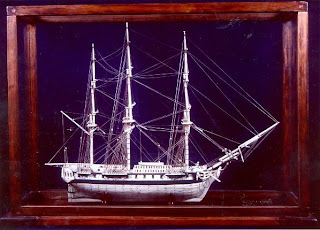Artifact Spotlight: Bone Ship Model of HMS Confiance
---Joshua Howard, Curatorial Volunteer
Ship models date back to ancient times and have often been seen as symbols of status and power. Artisans of these ships took great pains to make their models as accurate and detailed as possible and used the finest materials that they could acquire. This week’s artifact in spotlight is a beautiful and highly detailed model of the British frigate HMS Confiance made almost entirely of bone. The model measures over two feet long and more than a foot in height. The extremely detailed bone model is made up of hundreds of pieces of bone that have been fastened together to form the hull, masts, and spars. Anyone who views the model will not argue that the intricate carving of equipment, armament, rigging, and spar deck details are a wonder to behold. A ship's boat, figurehead, helm, hatch combings, gun carriages, deadeyes, blocks, fife rails, and a capstan are just some examples of the model maker's skill.
There have been nine vessels named Confiance in the British Royal Navy but it is believed that this model represents the 36-gun frigate that served as the British flagship at the Battle of Plattsburgh (also known as the Battle of Lake Champlain) on September 11, 1814. She was constructed at the Île aux Noix shipyard in Quebec and commanded by Captain George Downie. During the War of 1812, the frigate was quickly launched to aid the land-based British forces that were marching towards Plattsburgh, NY. The attack on American defenses at the lakeside town was undertaken to regain naval superiority of Lake Champlain. On the morning of September 11th as the final assault began, the British fleet sailed into Cumberland Bay, Lake Champlain and spotted the American fleet lead by Master Commandant Thomas Macdonough on his flagship USS Saratoga. Though Confiance had the advantage of long range guns that might have allowed her to fire at her adversary at a safe distance, Downie had been ordered to stay close to British land forces and thus moved the flagship in closer to the American fleet.
Macdonough’s fleet was ready to meet Downie and sailed into line, making it impossible for the British to advance without sailing right into a broadside. The ships began firing upon one another and within the first fifteen minutes of the engagement, a shot from Saratoga struck one of Confiance's guns. The impact threw the gun off its carriage and killed Captain Downie. After two and a half hours, Confiance stuck her colors in surrender. The naval battle resulted in an American victory when the British troops on land retreated. After the battle, Confiance was towed to Whitehall, NY where she was eventually purchased by the United States Navy but never put into service.
The model was donated to the museum in 1986 by Captain and Mrs. Jacob V. Heimark.
Images courtesy of the Naval War College Museum
 |
| Bone ship model of HMS Confiance |
Ship models date back to ancient times and have often been seen as symbols of status and power. Artisans of these ships took great pains to make their models as accurate and detailed as possible and used the finest materials that they could acquire. This week’s artifact in spotlight is a beautiful and highly detailed model of the British frigate HMS Confiance made almost entirely of bone. The model measures over two feet long and more than a foot in height. The extremely detailed bone model is made up of hundreds of pieces of bone that have been fastened together to form the hull, masts, and spars. Anyone who views the model will not argue that the intricate carving of equipment, armament, rigging, and spar deck details are a wonder to behold. A ship's boat, figurehead, helm, hatch combings, gun carriages, deadeyes, blocks, fife rails, and a capstan are just some examples of the model maker's skill.
 |
| Detail of the open spar deck on the HMS Confiance model |
There have been nine vessels named Confiance in the British Royal Navy but it is believed that this model represents the 36-gun frigate that served as the British flagship at the Battle of Plattsburgh (also known as the Battle of Lake Champlain) on September 11, 1814. She was constructed at the Île aux Noix shipyard in Quebec and commanded by Captain George Downie. During the War of 1812, the frigate was quickly launched to aid the land-based British forces that were marching towards Plattsburgh, NY. The attack on American defenses at the lakeside town was undertaken to regain naval superiority of Lake Champlain. On the morning of September 11th as the final assault began, the British fleet sailed into Cumberland Bay, Lake Champlain and spotted the American fleet lead by Master Commandant Thomas Macdonough on his flagship USS Saratoga. Though Confiance had the advantage of long range guns that might have allowed her to fire at her adversary at a safe distance, Downie had been ordered to stay close to British land forces and thus moved the flagship in closer to the American fleet.
Macdonough’s fleet was ready to meet Downie and sailed into line, making it impossible for the British to advance without sailing right into a broadside. The ships began firing upon one another and within the first fifteen minutes of the engagement, a shot from Saratoga struck one of Confiance's guns. The impact threw the gun off its carriage and killed Captain Downie. After two and a half hours, Confiance stuck her colors in surrender. The naval battle resulted in an American victory when the British troops on land retreated. After the battle, Confiance was towed to Whitehall, NY where she was eventually purchased by the United States Navy but never put into service.
The model was donated to the museum in 1986 by Captain and Mrs. Jacob V. Heimark.
Images courtesy of the Naval War College Museum


Comments
Post a Comment